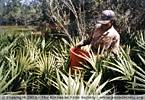 For Your Health and Beauty For Your Health and Beauty
by Pierre-Olivier Albano, 81100 Castres, France
Chamaerops No. 45, published online 29-01-2003
[an error occurred while processing the directive]
 
 
From left to right:
- Areca catechu, the Betel Nut Palm in Kandy, Sri Lanka.
- Elaeis guineensis, fruiting prolifically in the Botanical Garden Santo Domingo, Dominican Republic.
- Betel leaves and Areca nuts.
- Serenoa repens fruit being collected in Florida
Photos: Pierre-Olivier Albano.
Palm trees supply an unbelievably diverse number pf products. For centuries many of these have
been used to heal us or to enhance our beauty.Although the Areca family is relatively poor in secondary metabolites,
capable of producing pharmacological activity, certain traditional medicines used in tropical climes claim certain
therapeutic virtues.Similarly, the fruit and seeds, often oleaginous, are an important source for traditional
preparations, desired to beautify skin and hair. From a symbolic point of view, the palm tree has been the apothecary
emblem in France since 1777.
Scientific knowledge of the palm tree and its attributes passed into the western pharmacopoeia,
most notably the Betel Nut. This chewing mixture is largely used in southwest Asia, and is composed of several
ingredients. The leaves or inflorescences of the Pepper Betel (Piper betel) is only one ingredient. Others are
lime, tobacco, or other spices. In Asia, each region has its own recipe, but the Betel nut is ever present as
it contains the pharmacological substances arecaine and arecoline. The first is slightly narcotic and has never
been used in Europe. The second has worming properties and has been used for a long time in Europe for both
animals and humans against parasitic intestinal worms. Today, it has been replaced by synthetic substances,
less toxic and more effective. Even if it cannot be held responsible, it must be pointed out that regular chewing
of the Betel Nut has been linked to throat cancer.
Another traditional substance is the resin extracted from the fruits of Daemonorops draco (Willd.)
also known as Dragon Blood because of its bright red colour. Reputed for its antiseptic and healing qualities,
it was used until a few years ago in toothpaste in many European countries. Today, only Chinese medicine still
uses this.
Today, many types of palm trees are used in large quantities by the pharmaceutical and cosmetics
industries. The Saw Palmetto from Florida, (Serenoa repens (Bart.) Small) contains acids and sterols which are
highly therapeutic. Before Europeans arrived in Florida, the Seminole Indians used the fruits to treat urinary
problems. Early Americans used these fruits to treat such things as difficulty in urinating, as an aphrodisiac,
and even to increase breast size! It wasn’t until the 1970‘s that serious work was done with it, notably
in French and German laboratories. Today, the extract of the fruit is the base of many products used in the
treatment of the enlarged prostrate. In most Latin and German countries it is treated as a medicine and refunded
by the state. In Anglo-Saxon countries it is considered to be a food supplement and demand is rising rapidly.
This international success has led to an increase in demand for these fruits. 4000 tons of fruit are harvested
annually in Florida to satisfy demand. The fruits come from trees in the wild which are numerous. Their growth
rate is very slow, and there are no artificial plantations. Other extracts from this palm enter into cosmetic
products such as those created for oily skin and for the struggle against baldness. Homeopathic treatments use
these fruit for prostatitis.
The coconut (Cocos nucifera L.) produces Copra oil, used to make the famous Tahiti “Mono_”
(suntan lotion). One litre of oil is left to macerate with 12 gardenia taitensis flowers. Coconut oil is a base
product for greases and wetting agents, used for soaps. In fact, every time you use soap or shower gel, coprah
oil is almost certainly present as a wetting agent. Coconut milk is also used in cosmetics and homeopathic remedies
for certain allergies.
The palm Elaeis guineesis Jacq, the famous African oil palm, gives us oil from the fruit pulp
as well as from the stone. These are also widely used as fats, emulsions, and wetting agents in cosmetic formulations.
The fruit pulp contains vitamins A and E. These have anti-oxygenating properties which are being investigated
as food supplements.
The Brazilian wax palm (Copernica prunifera (Miller) H. Moore), formerly known as Copernica
cerifera, produces the high quality Carnuba wax. This wax is on the fronds which have to be cut to harvest the
wax. The younger the frond, the better the wax. The best wax is used for lip salves, lipsticks, and in pasta
– it gives it body. It is also used to cover tablets and to lubricate dental floss. There are other industrial
uses, but that’s another story.
These examples have all been for mass international usage, but there are also local uses. In
China they commercially use the Trachycarpus fortunei (Hook.) H. Wendl to stop bleeding. They also harvest the
fibres which cover the trunk. After charring, it is used in many traditional Chinese medicines.
If the uses of this family of palm trees is still limited, they are indeed one of the major
players in cosmetics, especially for fats and wetting agents coming from palm oils and coprah oil. The next
time that you use soap or lipstick (ladies) or treat your prostrate (gentlemen), don’t forget what you
owe to palms !

Readers Comments:
(No comments yet. Be the first to add a comment to
this article!)
|
 |
[an error occurred while processing the directive] |
